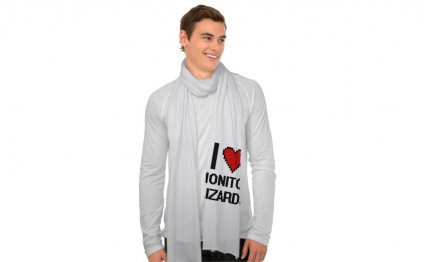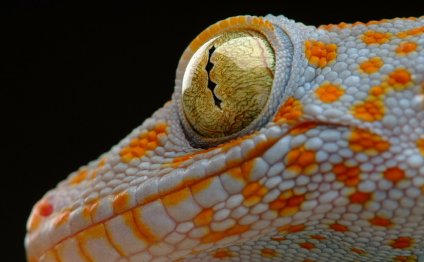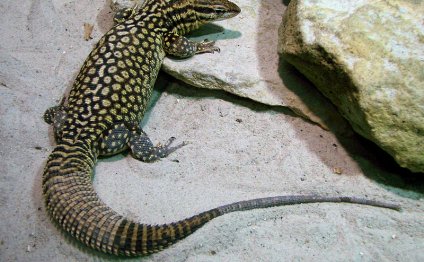
Pet monitor lizards
 Monitors are hardy lizards that can live long and happy lives. By supplying your monitor with proper care, food, habitat, and handling you help ensure you will have your pet for a very long time.
Monitors are hardy lizards that can live long and happy lives. By supplying your monitor with proper care, food, habitat, and handling you help ensure you will have your pet for a very long time.
Unfortunately, even with the best of care an injury or illness may still arise. When an unfortunate event happens to your pet it is always recommended that you seek advice from a veterinarian. Below are some of the more common illnesses and injuries that may befall a pet monitor.
Burns
A pet can get burned if it gets too close to a light or heat source. Minor burns can be treated with soapy water and antiseptic ointment. To prevent burns make sure all light and heat sources are located out of reach of a monitor.
Calcium & Vitamin D3 Deficiency
Metabolic bone disease is caused by a diet with a lack of calcium or vitamin D3, a lack of proper UVB lighting, or too much phosphorous in the diet. Symptoms include lethargy, weight loss, swollen limbs or jaw, other deformities, softening of bones, and constipation. Supplying your pet with proper lighting, the correct foods, and supplementing with calcium and vitamin D3 can help prevent this illness.
Calcium Over-Supplementation
Your pet monitor needs calcium and vitamin D3 to be healthy, but too much of a good thing is just as bad as none at all. Excessive supplementation can lead to hypercalcemia, too much calcium in the blood, which causes many health problems and possibly death. Supplementing a monitor’s food in moderation is the best way to prevent this illness. A pinch of a calcium & vitamin D3 supplement a couple times a week is usually enough for an adult monitor.
Constipation
A monitor does not pass waste at regular intervals. How often he goes may depend on temperature. A pet kept too cool will not pass waste as often and may have trouble digesting food. Making sure your pet’s home is at an appropriate temperature will aid in digestion and help prevent constipation.
A blockage or impaction can also be a cause of constipation. An impaction can be caused by a monitor eating something he shouldn’t, like small stones, sand, or other small items. It could also be caused by a lack of moisture in your pet’s digestive system. Making sure your monitor has a readily available source of fresh water will aid in keeping your pet hydrated and reduce the chances of constipation.
Infections
Monitors are tough reptiles and under normal conditions are rarely susceptible to infection. A stressed monitor or one living in a unsanitary habitat is much more likely to become ill. Symptoms of an infection can be swelling, discoloration, an abscess, and loss of appetite. Keeping your pet’s home clean and relatively stress free will help keep him healthy.
Injuries
Injuries and accidents happen and sometimes cause cuts or scrapes. You can treat a minor injury with soapy water and some antiseptic ointment. If an injury doesn’t heal or there is a a possible infection further medical attention will be required.
Broken bones and other severe injuries are often the result of accidents or improper handling. A trip to a veterinarian will be necessary.
Respiratory Infection
Symptoms of respiratory infection are sneezing, lethargy and rapid or shallow breathing. A respiratory infection can be caused by a habitat being too cold and too damp. Having a habitat with the proper temperature will help keep your monitor healthy.
Respiratory problems can also be a result of parasites which are often found in wild caught monitors. Roundworms and other parasites can lower a monitor’s immune system and make him more susceptible to illness. Veterinary treatment and maintaining a clean home for your pet can help reduce problems with parasites.
Shedding
Shedding is a natural occurrence as a monitor grows. Your pet may have patches of leftover shed, but it will usually fall off on its own. Sometimes shed skin will remain stuck on the toes and tail. To aid in shedding you can mist your pet with water or give him a warm bath.
Tail
A monitor may accidentally break or injure his tail. A broken tail may heal, but if there is a severe break or an infection it may have to be removed. A monitor does not have a tail that can break off as a defense mechanism and the tail will not regenerate.
Toes & Claws
Toes can sometimes get broken or injured from normal activity. Toes can get broken and nails torn out when a claw gets snagged on something. Pet monitors often have long sharp claws and trimming them can help prevent injury. The nails can be trimmed with a regular pair of nail clippers. Make sure you do not cut a nail too deep or you may hit a blood vessel and bleeding can occur. If you do cut too deep you can use a styptic pencil to stop the bleeding.
RELATED VIDEO



Share this Post
Related posts
Colorful lizard
A very large species of chameleon that is endemic to forests in eastern and northern Madagascar. They reach up to 68 cm (27…
Read MoreBest pet monitor lizards
Monitors are opportunistic carnivores and insectivores meaning they eat whatever animals and insects are available. In the…
Read More











